Positive Leadership
CHAPTER
1
Positive Leadership
As of this writing, more than 70,000 books on leadership are currently in print. Why would anyone want to produce one more? It is because the vast majority of these leadership books are based on the prescriptions of celebrated leaders recounting their own experiences, convenience samples of people’s opinions, or storytellers’ recitations of inspirational examples. This book is different. It relies wholly on strategies that have been validated by empirical research. It explains the practical approaches to leadership that have emerged from social science research. Because these strategies are not commonly practiced, this book provides some unusual but pragmatic strategies for leaders who want to markedly improve their effectiveness.
This book introduces the concept of positive leadership, or the ways in which leaders enable positively deviant performance, foster an affirmative orientation in organizations, and engender a focus on virtuousness and the best of the human condition. Positive leadership applies positive principles arising from the newly emerging fields of positive organizational scholarship (Cameron, Dutton, & Quinn, 2003; Cameron & Spreitzer, 2012), positive psychology (Seligman, 1999), and positive change (Cooperrider & Sriv-astva, 1987). It helps answer the question “So what can I do if I want to become a more positive leader?”
Positive leadership emphasizes what elevates individuals and organizations (in addition to what challenges them), what goes right in organizations (in addition to what goes wrong), what is life-giving (in addition to what is problematic or life-depleting), what is experienced as good (in addition to what is objectionable), what is extraordinary (in addition to what is merely effective), and what is inspiring (in addition to what is difficult or arduous). It promotes outcomes such as thriving at work, interpersonal flourishing, virtuous behaviors, positive emotions, and energizing networks. In this book the focus is primarily on the role of positive leaders in enabling positively deviant performance.
To be more specific, positive leadership emphasizes three different orientations:
(1) It stresses the facilitation of positively deviant performance, or an emphasis on outcomes that dramatically exceed common or expected performance. Facilitating positive deviance is not the same as achieving ordinary success (such as profitability or effectiveness); rather, positive deviance represents “intentional behaviors that depart from the norm of a reference group in honorable ways” (Spreitzer & Sonenshein, 2003: 209). Positive leadership aims to help individuals and organizations attain spectacular levels of achievement.
(2) It emphasizes an affirmative bias, or a focus on strengths and capabilities and on affirming human potential (Buckingham & Clifton, 2001). Its orientation is toward enabling thriving and flourishing at least as much as addressing obstacles and impediments. Without being Pollyannaish, it stresses positive communication, optimism, and strengths, as well as the value and opportunity embedded in problems and weaknesses.
Positive leadership does not ignore negative events and, in fact, acknowledges the importance of the negative in producing extraordinary outcomes. Difficulties and adverse occurrences often stimulate positive outcomes that would never occur otherwise. Being a positive leader is not the same as merely being nice, charismatic, trustworthy, or a servant leader (Conger, 1989; Greenleaf, 1977). Rather, it incorporates these attributes and supplements them with a focus on strategies that provide strengths-based, positive energy to individuals and organizations.
(3) The third connotation emphasizes facilitating the best of the human condition, or a focus on virtuousness (Cameron & Caza, 2004; Spreitzer & Sonenshein, 2003). Positive leadership is based on a eudaemonistic assumption; that is, an inclination exists in all human systems toward goodness for its intrinsic value (Aristotle, Metaphysics XII; Dutton & Sonenshein, 2007). Whereas there has been some debate regarding what constitutes goodness and whether universal human virtues can be identified, all societies and cultures possess catalogs of traits they deem virtuous (Dent, 1984; Peterson & Seligman, 2004). Positive leadership is oriented toward developing what Aristotle labeled goods of first intent, or to “that which is good in itself and is to be chosen for its own sake” (Aristotle, Metaphysics XII: 3). An orientation exists, in other words, toward fostering virtuousness in individuals and organizations.
CRITICISMS AND CONCERNS
To be fair, some are very skeptical of an emphasis on positive leadership. They claim that a focus on the positive is “saccharine and Pollyannaish,” “ethnocentric and representing a Western bias,” “ignorant of negative phenomena,” “elitist,” “mitigates against hard work and invites unpre-paredness,” “leads to reckless optimism,” “represents a narrow moral agenda,” and even “produces delusional thinking” (see Ehrenreich, 2009; Fineman, 2006; George, 2004; Hackman, 2008). They imply that it represents a new age opiate in the face of escalating challenges. One author maintains that not only is there little evidence that posi-tivity is beneficial but, in fact, it is harmful to organizations (Ehrenreich, 2009).
This book aims to provide the evidence that the reverse is actually true. Positive leadership makes a positive difference. The positive strategies described here are universal across cultures. Cultural differences may alter the manner in which these strategies are implemented, but evidence suggests that the strategies themselves are universal in their effects. They exemplify a heliotropic effect—or an inclination in all living systems toward positive, life-giving forces. They have practical utility in difficult circumstances as much as in benevolent circumstances.
Far from mitigating against hard work or representing soft, simple, and syrupy actions, these strategies require effort, elevated standards, and genuine competence. The strategies represent pragmatic, validated levers available to leaders so that they can achieve positive performance in organizations and in individuals. The empirical evidence presented in the chapters that follow is offered to support this conclusion.
AN EXAMPLE OF POSITIVE DEVIANCE
An easy way to identify positive leadership is to observe positive deviance. An example of such performance is illustrated by the cleanup and closure of the Rocky Flats Nuclear Weapons Production Facility near Denver, Colorado (Cameron & Lavine, 2006). At the time the facility was rife with conflict and antagonism. It had been raided and temporarily closed by the Federal Bureau of Investigation in 1989 for alleged violations of environmental laws, and employee grievances had skyrocketed. More than 100 tons of radioactive plutonium were on site, and more than 250,000 cubic meters of low-level radioactive waste were being stored in temporary drums on the prairie. Broad public sentiment regarded the facility as a danger to surrounding communities, and demonstrations by multiple groups had been staged there from the 1960s through the 1980s in protest of nuclear proliferation and potential radioactive pollution. In fact, radioactive pollution levels were estimated to be so high that a 1994 ABC Nightline broadcast labeled two buildings on the site the most dangerous buildings in America.
The Department of Energy estimated that closing and cleaning up the facility would require a minimum of 70 years and cost more than $36 billion. A Denver, Colorado, engineering and environmental firm—CH2MHILL—won the contract to clean up and close the 6,000-acre site consisting of 800 buildings.
CH2MHILL completed the assignment 60 years ahead of schedule, $30 billion under budget, and 13 times cleaner than required by federal standards. Antagonists such as citizen action groups, community councils, and state regulators changed from being adversaries and protesters to advocates, lobbyists, and partners. Labor relations among the three unions (i.e., steelworkers, security guards, building trades) improved from 900 grievances to the best in the steelworker president’s work life. A culture of lifelong employment and employee entitlement was replaced by a workforce that enthusiastically worked itself out of a job as quickly as possible. Safety performance exceeded federal standards by twofold and more than 200 technological innovations were produced in the service of faster and safer performance.
These achievements far exceeded every knowledgeable expert’s predictions of performance. They were, in short, a quintessential example of positive deviance achieved by positive leadership. The U.S. Department of Energy attributed positive leadership, in fact, as a key factor in accounting for this dramatic success (see Cameron & Lavine, 2006: 77).
Of course, for positive leaders to focus on positive deviance does not mean that they ignore nonpositive conditions or situations where mistakes, crises, deterioration, or problems are present. Most of the time people and organizations fall short of achieving the best they can be or fail to fulfill their optimal potential. Many positive outcomes are stimulated by trials and difficulties; for example, demonstrated courage, resilience, forgiveness, and compassion are relevant only in the context of negative events. As illustrated by the Rocky Flats example, some of the best of human and organizational attributes are revealed only when confronting obstacles, challenges, or detrimental circumstances. Common human experience, as well as abundant scientific evidence, supports the idea that negativity has a place in human flourishing (Cameron, 2008). Negative news sells more than positive news, people are affected more by negative feedback than positive feedback, and traumatic events have a greater impact on humans than positive events.
A comprehensive review of psychological research by Baumeister, Bratslavsky, Finkenauer, and Vohs (2001: 323) summarized this conclusion by pointing out that “bad is stronger than good.” Human beings, they maintained, react more strongly to negative phenomena than to positive phenomena. They learn early in life to be vigilant in responding to the negative and to ignore natural heliotropic tendencies. Thus achieving positive deviance is not dependent on completely positive conditions, just like languishing and failure are not dependent on constant negative conditions. A role exists for both positive and negative circumstances in producing positive deviance (Bagozzi, 2003), and both conducive and challenging conditions may lead to positive deviance. As everyone knows, “all sunshine makes a desert.”
Moreover, when organizations should fail but do not, when they are supposed to wither but bounce back, when they ought to become rigid but remain flexible and agile, they also demonstrate a form of positive deviance (Weick, 2003). The cleanup and closure of Rocky Flats was expected to fail; nuclear aircraft carriers in the 1990 Persian Gulf War were not supposed to produce perfect performance (Weick & Roberts, 1993); and the U.S. Olympic hockey team in 1980 was predicted to be annihilated by the Russians. Nonfailure in these circumstances also represents positive deviance.
One way to think about positive deviance is illustrated by a continuum shown in Figure 1.1. The continuum depicts a state of normal or expected performance in the middle, a condition of negatively deviant performance on the left, and a state of positively deviant performance on the right. Negative deviance and positive deviance depict aberrations from normal functioning, problematic on one end and virtuous on the other end.
FIGURE 1.1 A Deviance Continuum
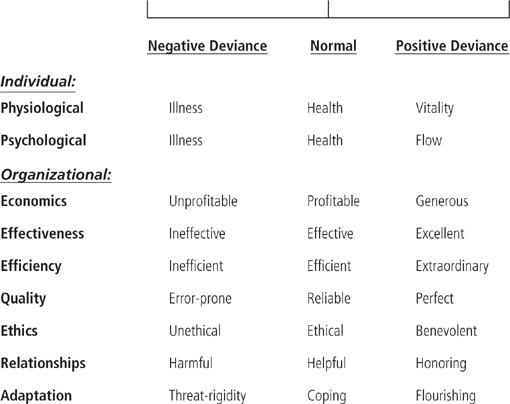
(SOURCE: Cameron, 2003)
The figure shows a condition of physiological and psychological illness on the left and healthy functioning in the middle (i.e., the absence of illness). On the right side is positive deviance, which may be illustrated by high levels of physical vitality (e.g., Olympic fitness levels) or psychological flow (Csikszentmihalyi, 1990; Fredrickson, 2001). At the organizational level, the figure portrays conditions ranging from ineffective, inefficient, and error-prone performance on the left side to effective, efficient, and reliable performance in the middle. On the right side is extraordinarily positive, virtuous, or extraordinary organizational performance. The extreme right and left points on the continuum are qualitatively distinct from the center point. They do not merely represent a greater or lesser quantity of the middle attributes.
For the most part, organizations are designed to foster stability, steadiness, and predictability (March & Simon, 1958; Parsons, 1951; Weber, 1992)—that is, to remain in the middle of the Figure 1.1 continuum. Investors tend to flee from companies that are deviant or unpredictable in their performance (Marcus, 2005). Consequently, organizations formalize expectations, reporting relationships, goals and targets, organizational rules, processes and procedures, strategies, and structures—all intended to reduce variation, uncertainty, and deviance. Most organizations, and most leaders, focus on maintaining performance at the center of the continuum, so most performance is neither positively nor negatively deviant (Quinn, 2004; Spreitzer & Sonenshein, 2003). Success is traditionally represented as effective performance at the center of the continuum— predictable trends, reliable functioning, and expectedly profitable operations.
On the other hand, a few organizations perform in extraordinary ways—at the right end of the continuum—but they are the exception, not the rule. They are positively deviant, and this implies more than just being profitable. Positive deviance almost always entails more than merely earning more revenue than the industry average for a certain number of years (as in Collins, 2001). It involves thriving, flourishing, and even virtuous performance, or achieving the best of the human condition.
Of course, no single leader can account for this kind of spectacular success, but certain leadership strategies have been found to enable organizational thriving, flourishing, and extraordinarily positive performance. This book highlights four of these enabling strategies and provides the empirical evidence that supports their validity.
LEADERSHIP THAT ENABLED POSITIVE DEVIANCE—CASE 1
One example of leadership that led to positive deviance occurred in a New England health-care facility—Griffin Hospital—which faced a crisis when the popular vice president of operations, Patrick Charmel, was forced to resign by the board of directors (Cameron & Caza, 2002). Most employees viewed him as the most innovative and effective administrator in the hospital and as the chief exemplar of positive energy and hope for the future. Upon his resignation, the organization was thrown into turmoil. Conflict, backbiting, criticism, and adversarial feelings permeated the system. Eventually a group of employees formally appealed to the board of directors to replace the current president and CEO with Charmel. Little confidence was expressed in the current leadership, and the hospital’s performance was deteriorating. The group’s lobbying efforts were eventually successful in that the president and CEO resigned under pressure, and Charmel was hired back to fill those two roles.
Within six months of his return, however, the decimated financial circumstances at the hospital necessitated a downsizing initiative aimed at reducing the workforce by at least 10 percent. The hospital faced millions of dollars in losses. Charmel had to eliminate the jobs of some of the very same people who had supported his return.
The most likely consequences of this action would normally be an escalation in the negative effects of downsizing (Cameron, 1994), for example, loss of loyalty and morale, perceptions of injustice and duplicity, blaming and accusations, and cynicism and anger. Given the research on the effects of downsizing, one might expect that a continuation of the tumultuous, antagonistic climate was almost guaranteed (Cameron, 1998; Cameron, Kim, & Whetten, 1987).
Instead, the opposite results occurred. Upon his return, Charmel made a concerted effort to implement strategies that enabled positively deviant change rather than merely manage the problems. He focused on fostering a positive climate rather than allowing a negative one to develop, where strong relationships, open and honest communication, and meaningfulness of work were emphasized. He helped the organization institutionalize forgiveness, optimism, trust, and integrity as expected behaviors. Throughout the organization, stories of compassion and acts of kindness and virtuousness were almost daily fare.
One typical example involved a nurse who was diagnosed with terminal cancer. Respondents reported that when word spread of the man’s illness, doctors and staff members from every area in the hospital donated vacation days and personal leave time so that he would continue to collect a salary even though he could not work. Fortuitously, the pool of days expired just before the nurse died, so he was never terminated, and he received a salary right up to his last day of life.
Employees reported that both the personal damage and the organizational damage done by the announced downsizing—friends losing jobs, budgets being cut—were forgiven, employees released grudges and resentment, and, instead, an optimistic future was emphasized. The language used throughout the organization commonly included words such as love, hope, compassion, forgiveness, and humility, especially in reference to the leadership that announced the downsizing actions.
We are in a very competitive health care market, so we have differentiated ourselves through our compassionate and caring culture…. I know it sounds trite, but we really do love our patients…. People love working here, and our employees’ family members love us too…. Even when we downsized, Pat [Charmel] maintained the highest levels of integrity. He told the truth, and he shared everything. He got the support of everyone by his genuineness and personal concern…. It wasn’t hard to forgive. (representative response in a focus group interview of employees, cited in Cameron, 2003: 56)
Employees indicated that the climate of positivity established by Charmel was the key to their recovery and thriving. For example, the maternity ward installed double beds (which had to be newly designed) so that fathers could sleep with mothers rather than sitting in a chair through the night. The hospital created numerous communal rooms for family and friend gatherings and carpeted hallways and floors. Volunteer pets were brought in to comfort and cheer up patients. Original paintings on walls displayed optimistic and inspiring themes. Nurses’ stations were all within eyesight of patients’ beds. Jacuzzis were installed in the maternity ward.
Since then, Griffin is the only hospital to be listed in Fortune’s “Top 100 Best Places to Work” ten years in a row. Griffin is one of three hospitals in the United States to be honored with a “Distinction for Leadership and Innovation in Patient-Centered Care Award.” It ranks in the top 5 percent of “Distinguished Hospitals for Clinical Excellence,” and patients receiving care at such a hospital average a 71 percent lower chance of mortality and a 14 percent lower risk of complications. Griffin also received the Platinum Innovation Prize. As might be expected, revenues have soared. Figure 1.2 illustrates the revenue turnaround just after Charmel took office.
FIGURE 1.2 Financial Performance after a Leadership Intervention
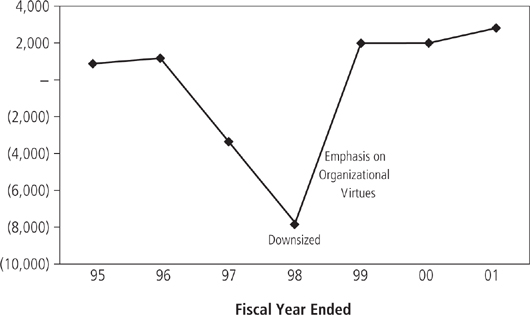
(SOURCE: Cameron, 2003)
LEADERSHIP THAT ENABLED POSITIVE DEVIANCE—CASE 2
A second illustration of positive leadership is Jim Mallozzi, CEO of Prudential Real Estate and Relocation Company, and formerly a senior vice president and head of integration at Prudential Retirement. Mallozzi was initially brought into Prudential Retirement to help with the merger of Cigna Retirement and Prudential Retirement. He described the challenge this way:
Talk about trying to merge the Red Sox and the Yankees. We had two distinct cultures—one from New England and the other one from the New York/New Jersey area— and both were very strong, very passionate, and very powerful. As you can imagine, trying to put these two cultures together was difficult.
Mallozzi helped implement a variety of positive leadership strategies and reported:
It helped us very successfully integrate the cultures. The company went on to produce some record earnings. We kept 98 percent of our clients. Our annual employee satisfaction scores and employee opinion survey results went up dramatically. We had less voluntary turnover, and the earnings of the company started going up at about 20 percent per annum on a compound rate. It was a real success story. I think that positive strategies helped us create the benchmark for how you take two distinct companies and put them together. (see Vannette & Cameron, 2008, for a description of the strategies)
A few years later, when Mallozzi was appointed CEO of another Prudential Company—which had suffered a $140 million loss the year before—he again turned to the empirically grounded positive leadership strategies described in this book. Inspirational stories and motivational techniques had been tried in the past, so he was not inclined to merely try motivational leadership. He once again helped the firm achieve dramatic results by implementing positive leadership strategies.
We started with a variety of exercises to show our employees that when you start with the positive … fabulous things can happen…. We went from an 80 million dollar loss to a 20 million profit that year, and we actually achieved two times our expected business plan. We doubled our profits from what we’d expected. Our employee satisfaction scores went up in nine out of twelve categories. (see Cameron & Plews, in press, for examples of the exercises)
In sum, positive leaders focus on organizational flourishing, enabling the best of the human condition and creating exceptionally positive outcomes, not merely on resolving problems, overcoming obstacles, increasing competitiveness, or even attaining profitability. These outcomes may be achieved in difficult circumstances—as in the cases of Griffin Hospital and the Prudential companies—as well as in benevolent circumstances. The key is a focus on positive leadership.
EFFECTS OF POSITIVITY ON INDIVIDUALS
Plenty of evidence exists that a focus on the positive affects individuals as well as organizations. It is largely because individuals flourish in the presence of positive leadership that organizations do well (Caza & Cameron, 2008). Figures 1.3-1.10 summarize the findings of more than 40 studies showing the effects of positivity on individuals.
These graphs merely synopsize a sampling of the findings from multiple studies and show trends rather than provide details. References are provided for those interested in more detail regarding the statistical analyses associated with each study.
These figures illustrate the impact of positivity on individuals’ heart rate, blood pressure, inflammation, and cortisol levels after exposure to stressors. They show the effects of positivity on anti-aging hormone production, brain activity, and death rates among an aged population over an 80-month period. All told, the results of multiple studies provide consistent and convincing evidence that positive practices produce positive physiological benefits and, in turn, positively affect performance (see also Dutton & Ragins, 2007).
FIGURE 1.3 Blood Pressure Recovery after Exposure to a Major Stressor—Comparison of High versus Low Positive Emotions and Positive Practices
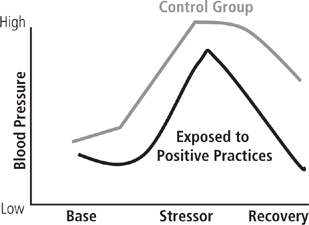
(SOURCE: Dockray & Steptoe, 2010)
FIGURE 1.4 Cortisol Levels after Exposure to a Major Stressor—Comparison of High versus Low Positive Emotions and Positive Practices
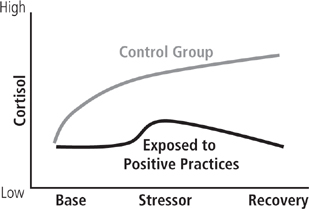
(SOURCE: Bostock et al., 2011)
FIGURE 1.5 Inflammation Levels—Comparison of High versus Low Positive Emotions and Positive Practices
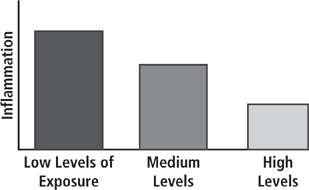
(SOURCE: Dockray & Steptoe, 2010)
FIGURE 1.6 Death Rates in People over Age 70—Comparison of High versus Low Positive Emotions and Positive Practices
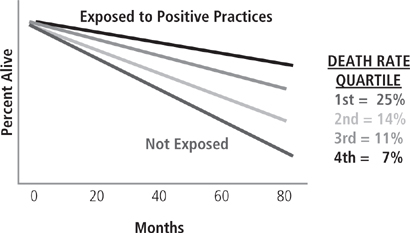
(SOURCE: Chida & Steptoe, 2008)
FIGURE 1.7 DHEA (Anti-Aging Hormone) Levels—Comparison of High versus Low Positive Emotions and Positive Practices
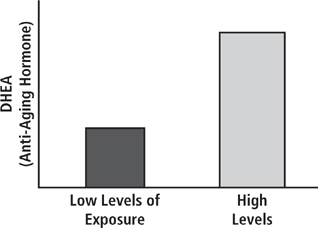
(SOURCE: Van Reekum et al., 2010)
FIGURE 1.8 Post-Lyme Disease Symptoms—Comparison of High versus Low Positive Emotions and Positive Practices
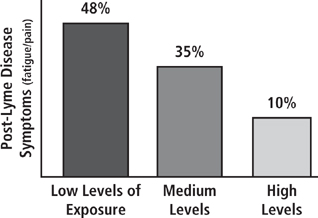
(SOURCE: Hasset et al., 2009)
FIGURE 1.9 Brain Activity in ADHD Children—Comparison of Trained and Untrained Children in Positive Emotions and Positive Practices
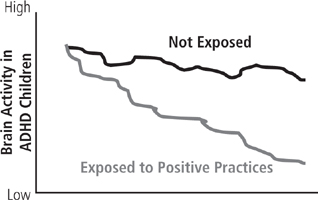
(SOURCES: Lutz, Slagter, Dunne, & Davidson, 2008; Van der Oord, Bogels, & Beijnenburg, 2011)
FIGURE 1.10 Wound Healing—Comparison of Trained and Untrained People in Positive Emotions and Positive Practices
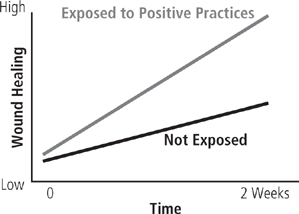
(SOURCE: Robles, Brooks, & Pressman, 2009)
FIGURE 1.11 Four Leadership Strategies That Enable Positive Deviance
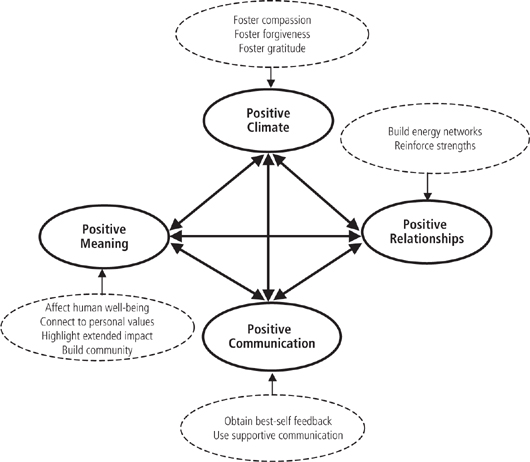
POSITIVE LEADERSHIP
Each of the chapters that follow discusses a key positive leadership strategy that differentiates positively deviant organizations from normal organizations. These strategies do not represent a comprehensive or an exclusive list, of course, but observation and empirical evidence from a number of investigations suggest that they are among the most important enablers of positively deviant performance. However, they are too seldom practiced. These four leadership strategies are interrelated and mutually reinforcing. As illustrated in Figure 1.11, enhancing one of these strategies tends to positively impact the other three.
In addition to reviewing why each strategy is important and how it is related to positively deviant performance, each chapter includes a brief description of some practical activities for implementing the positive strategy, some diagnostic questions for leaders, and some references to the validating research.
Chapter 6 explains a process for implementing these four strategies in an organization—the Personal Management Interview program. Empirical evidence shows that implementing this process as part of a positive leadership strategy fosters marked improvement in individual and organizational performance. The concluding chapter summarizes the principles of positive leadership and provides a process and an assessment instrument to help leaders begin to implement the most personally relevant leadership behaviors.




















